Uzbekistan, Turkmenistan, Tajikistan & Kyrgyzstan Tour
16 Days Private Tour of Tashkent - Nukus - Muynak - Kunya Urgench - Darvaza - Khiva - Bukhara - Samarkand - Panjakent - Istaravshan - Khujand - Kokand - Fergana - Andijan - Osh - Bishkek - Chon Kemin - Burana Tower - Bishkek
Tour Type: Private guided tour, flexible and customizable
Transportation: Comfortable air-conditioned private car with driver
Accommodation: 3 to 4-star hotels, guesthouses & yurt camps, open to your choice
Meals: 15 breakfasts, 1 dinner
Code: TCA107
Transportation: Comfortable air-conditioned private car with driver
Accommodation: 3 to 4-star hotels, guesthouses & yurt camps, open to your choice
Meals: 15 breakfasts, 1 dinner
Code: TCA107
This trip can be customized to meet your individual needs!
Free InquiryGet our reply within 24 hours!
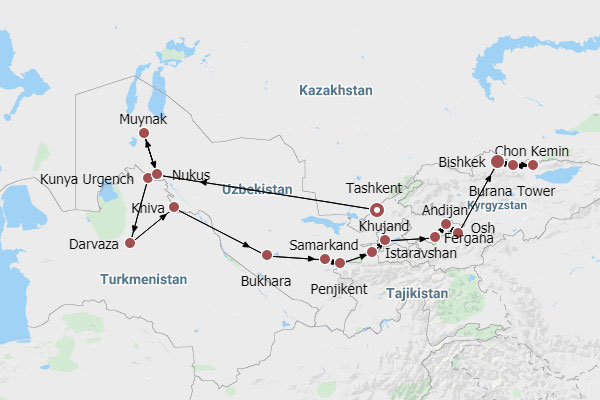
- Itinerary
- Reviews
Trip Highlights
- Trace the history of the Silk Road by viewing grand mausoleums in Samarkand and the well-restored inner city of Khiva in Uzbekistan.
- Explore the hundred-year-old artificial techniques of ceramics production in Rishton and hand-loomed silk textiles in Margilan in Uzbekistan.
- Take pictures with the eternal flames of the Darvaza Gas Crater and enjoy a BBQ dinner under the starry sky in Turkmenistan.
- Trek in the Ala Archa National Park to explore the alpine valley of Kyrgyzstan.
- Trace the footprint of the Sogdians by visiting the local museum in Penjikent, Tajikistan.
Expand All
Collapse All
Day 1 Airport Pick-up in Tashkent, Uzbekistan; City Tour: Khast-Imam Complex, State Museum of Applied Arts
Central Asian Plov Centre in Tashkent
First, head to the Khast-Imam Complex. Framed by two Islamic schools, a mausoleum, and a mosque, it is Tashkent's spiritual heart, providing a condensed vision of Islamic buildings. Its crown jewel is undoubtedly the Tilla Sheikh Mosque, which has the world's oldest Quran manuscript, drawing countless pilgrims and Islamic history enthusiasts. Inside, the main hall is adorned with deep blue carpets, while the white ceiling features intricate floral and vine bas-reliefs, creating a celestial blue-and-white ambiance.
Next, we’ll weave through the vibrant stalls of Chorsu Bazaar, one of Central Asia’s oldest markets, to reach the State Museum of Applied Arts, which showcases the artistry from the 19th century onward, such as potteries, silk textiles, wooden carvings, traditional Central Asian skullcaps, and amulets inlaid with lapis lazuli. Among all exhibits, the suzani embroidery is the most stunning, which features repeating geometric patterns or floral vines.
Leaving the museum, let’s experience Tashkent’s remarkable metro system and admire its aesthetic stations. The Independence Square Station, where towering marble columns support the ceiling, together with ornate crystal chandeliers, evokes a grand medieval European palace. Getting off the metro at Independence Square, we will proceed to Amir Timur Square to take a picture of the conqueror who once dominated Central Asia. The day will conclude at the Earthquake Memorial. Finally, the driver will transfer you to the hotel.
1. Visa: As this itinerary involves multiple entries into Uzbekistan, visitors who need an e-visa must apply for a multiple-entry visa 1-2 weeks in advance, including most US citizens. However, U.S. passport holders under 16 and over 55, as well as citizens of 66 other countries, including Canada and the United Kingdom, can enter visa-free.
2. Payment Method: While credit cards are accepted in some restaurants and shops, the Uzbekistani som (UZS) is far more widely used. Exchange some UZS cash at the ATMs with Visa, Mastercard, or USD in cash. Approximately USD 200 equivalent in local currency is generally sufficient for expenses over five days.
Accommodation: Wyndham Tashkent (4 stars) or similar
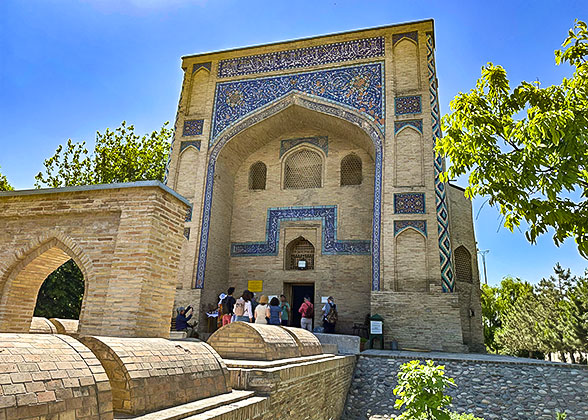
Khast-Imam Complex
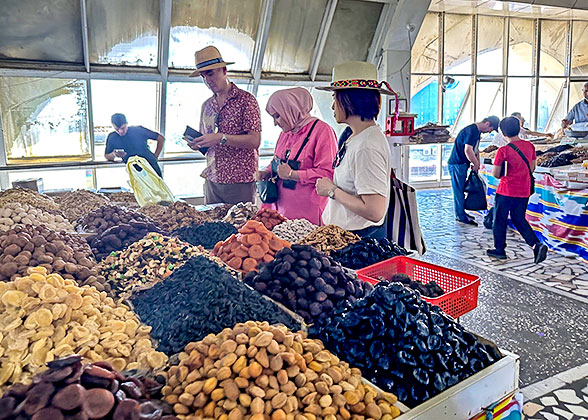
Chorsu Bazaar
Day 2 Fly to Nukus; Drive to Cemetery of Ships in Muynak; Return to Nukus
After breakfast, the driver will escort you to the Tashkent airport, where an early morning flight will take you to Nukus, the country’s sixth-largest city, home to the fast-disappearing Aral Sea and some of the finest Soviet art masterpieces. Upon arrival, your local driver will escort you to the Savitsky Karakalpakstan Art Museum, a miraculous cultural oasis housing a collection of Russian avant-garde art from the 19th to the 20th centuries. Among its 40,000 works, The Bull ranks as the centerpiece, in which the blue animal’s haunting eyes seem to pierce your mind and bring a feeling of unsettlement. Beyond paintings, you can discover Karakalpak folk crafts, such as daggers, bridal headdresses, coral necklaces, and ancient Zoroastrian ossuaries and inscribed stelae.
Then, embark on a 3-4 hour drive to the Cemetery of Ships in Muynak, which was once a bustling fishing port on the shore of the Aral Sea, a vast inland lake spanning 68,000 sq km for over five million years, but desiccated in the 1960s due to human activities. The formerly flourishing harbor has transformed into a desert, leaving fleets run aground. Besides the skeletal hulls, the remnants of the forgotten lighthouses are witnesses to this environmental catastrophe. For a deeper exploration of the Aral Seal’s history and the Muynak, we will visit the Regional History and Aral Sea Museum nearby.
Afterwards, we’ll drive back to Nukus and visit the ancient Mizdakhan Necropolis on the way. Originating as a Zoroastrian sacred site, it became a major Muslim burial ground after the Arab conquest in the 8th century. Climbing to the hillside behind the cemetery for a panoramic view, you’ll find that the structure of the tombs resembles roofless houses. At the end of the day, the driver will transfer you back to the hotel in Nukus.
 Funeral Customs of Zoroastrianism
Funeral Customs of Zoroastrianism
Zoroastrianism, one of the world's oldest continuously practiced religions, emerged around 1500-1200 BC in the Khorezm region, which encompasses modern Nukus and Muynak. It demonstrated a profound reverence for natural elements, believing that water, air, fire, and earth are sacred. So in their funeral ritual, a corpse was conventionally placed on a platform to be eaten by vultures, and only the remaining bones would be collected in an ossuary.
Meals: Breakfast
Accommodation: Tashkent Hotel, Nukus (3 stars) or similar
Then, embark on a 3-4 hour drive to the Cemetery of Ships in Muynak, which was once a bustling fishing port on the shore of the Aral Sea, a vast inland lake spanning 68,000 sq km for over five million years, but desiccated in the 1960s due to human activities. The formerly flourishing harbor has transformed into a desert, leaving fleets run aground. Besides the skeletal hulls, the remnants of the forgotten lighthouses are witnesses to this environmental catastrophe. For a deeper exploration of the Aral Seal’s history and the Muynak, we will visit the Regional History and Aral Sea Museum nearby.
Afterwards, we’ll drive back to Nukus and visit the ancient Mizdakhan Necropolis on the way. Originating as a Zoroastrian sacred site, it became a major Muslim burial ground after the Arab conquest in the 8th century. Climbing to the hillside behind the cemetery for a panoramic view, you’ll find that the structure of the tombs resembles roofless houses. At the end of the day, the driver will transfer you back to the hotel in Nukus.
Zoroastrianism, one of the world's oldest continuously practiced religions, emerged around 1500-1200 BC in the Khorezm region, which encompasses modern Nukus and Muynak. It demonstrated a profound reverence for natural elements, believing that water, air, fire, and earth are sacred. So in their funeral ritual, a corpse was conventionally placed on a platform to be eaten by vultures, and only the remaining bones would be collected in an ossuary.
Meals: Breakfast
Accommodation: Tashkent Hotel, Nukus (3 stars) or similar
Day 3 Cross the Turkmenistan Border, Visit Kunya-Urgench, Drive to Darvaza
Today, we’ll temporarily bid farewell to Uzbekistan. The driver will send you to the Uzbekistan-Turkmenistan border. After the transit formalities, the Turkmenistan driver and the guide will pick you up and transfer you to Kunya-Urgench, a city dating back to the 6th century. Regarded as an open-air museum, it preserves the main structures from the past, such as caravanserais, mosque minarets, and mausoleums, among which the Nedjmeddin Kubra Mausoleum is a must-visit spot. The mausoleum was built to honor a Sufi saint who was martyred in the war against the Mongols. Stepping inside, you could see a tombstone standing at the center, which is said to mark the resting place of Kubra’s body, while the 2-meter-high (6-foot) column next to it dignifies where his head fell. Then, we will continue to the hexagonal Turabek Khanum Mausoleum, which is considered one of Central Asia’s most perfect architectural masterpieces. Passing by the Mamun Minaret, we will proceed to Kunya-Urgench’s tallest tower, the Kutlug Timur Minaret. End the old city’s sightseeing at the Kyrkmolla Mausoleum, the resting place of 40 saints who sacrificed in the war against the Mongols, and Kunya-Urgench’s oldest building, the Il Arslan Mausoleum, which is outstanding with its cylindrical roof.
We’ll then dash southward to the Darvaza Gas Crater, dropping by small Mud and Water Craters. Also known as the “Door to Hell,” the 70-meter-wide (230-foot), 30-meter-deep (100-foot) methane gas crater was formed by a drilling accident during a Soviet geological exploration in 1971. To prevent the dispersion of the toxic gases, geologists ignited the leakage. Unexpectedly, the fire has been burning for more than five decades. If we arrive at the crater at dusk, you can see the sky shift from blue into grey, and finally turn into a black velvet shrouding the orange fire. Enjoy a barbecue dinner near the pit while listening to the crackling of the fire and admiring the starry sky. Do not miss the chance to take a picture standing at the edge of the crater. Today, you’ll stay overnight at the yurt camp.
►Tips:
1. It is quite bumpy on the way to the Darvaza Gas Crater, so please remember to take some Dramamine if you have car sickness.
2. The temperature of the crater is high, so it is better to be cautious and not to be so close to the edge of the pit.
3. Since it may be cold at night in the desert, please prepare a jacket or coat to keep warm. Besides, it is windy and dusty, so take wind- and sand-proof gear.
 Turkmenistan Insider Information:
Turkmenistan Insider Information:
1. Entry Requirement: All visitors to Turkmenistan are required to have a visa, which can only be applied for by holding a government-approved letter of invitation (LOI) issued through a licensed tour operator like ours. It generally takes 1-2 months from LOI issuance and visa approval, so we suggest you book the tour at least 3 months in advance.
2. Internet Access: Popular platforms, such as Facebook, WhatsApp, and Instagram, are not available in Turkmenistan. To stay connected, a local TM Cell SIM card is helpful, costing USD 38 for a SIM card and USD 22 for a 2 GB data package.
Meals: Breakfast, BBQ Dinner
Accommodation: Yurt Camp in Darvaza
We’ll then dash southward to the Darvaza Gas Crater, dropping by small Mud and Water Craters. Also known as the “Door to Hell,” the 70-meter-wide (230-foot), 30-meter-deep (100-foot) methane gas crater was formed by a drilling accident during a Soviet geological exploration in 1971. To prevent the dispersion of the toxic gases, geologists ignited the leakage. Unexpectedly, the fire has been burning for more than five decades. If we arrive at the crater at dusk, you can see the sky shift from blue into grey, and finally turn into a black velvet shrouding the orange fire. Enjoy a barbecue dinner near the pit while listening to the crackling of the fire and admiring the starry sky. Do not miss the chance to take a picture standing at the edge of the crater. Today, you’ll stay overnight at the yurt camp.
►Tips:
1. It is quite bumpy on the way to the Darvaza Gas Crater, so please remember to take some Dramamine if you have car sickness.
2. The temperature of the crater is high, so it is better to be cautious and not to be so close to the edge of the pit.
3. Since it may be cold at night in the desert, please prepare a jacket or coat to keep warm. Besides, it is windy and dusty, so take wind- and sand-proof gear.
1. Entry Requirement: All visitors to Turkmenistan are required to have a visa, which can only be applied for by holding a government-approved letter of invitation (LOI) issued through a licensed tour operator like ours. It generally takes 1-2 months from LOI issuance and visa approval, so we suggest you book the tour at least 3 months in advance.
2. Internet Access: Popular platforms, such as Facebook, WhatsApp, and Instagram, are not available in Turkmenistan. To stay connected, a local TM Cell SIM card is helpful, costing USD 38 for a SIM card and USD 22 for a 2 GB data package.
Meals: Breakfast, BBQ Dinner
Accommodation: Yurt Camp in Darvaza
Day 4 Cross the Uzbekistan Border; Drive to Khiva
In the morning, just take a short hike to the nearby dunes on your own, where you may have a chance to overlook the crimson crater with a backdrop of the indigo sky. Or head to the edge of the crater to have a last peek at its dancing flame. If lucky, you may witness the half-meter-high spurts of scarlet mud bursting from the crater floor.
After that, our driver will escort you to the border, where you’ll re-enter Uzbekistan to Khiva with a local driver, taking about 6 hours on the way. For centuries, this ancient city served as a vital resupply hub for caravans traversing the desert. Upon arrival, you’ll be sent to the hotel for check-in. Have a good rest at the hotel to refresh from the jolting road trip.
 Restaurant Recommendation (at your own expense):
Restaurant Recommendation (at your own expense):
If you want to fill your stomach, Ayvon Zarafshon Restaurant is recommended. Stepping into the restaurant, you’ll feel like you are in a European palace with marble floors, ceilings hung with chandeliers, and walls decorated with intricate Central Asian patterns. Window seats offer magical views of distant illuminated minarets in the evening. Do not miss its Shivit Oshi, and the green noodles get their color from fresh dill juice. Traditionally, stewed beef or lamb with potatoes and carrots is added as a topping, and it is often served with sour cream or yogurt. Besides, classic Uzbek kebabs and salads are also worth trying.
Average Cost per Person: UZS 100,000-150,000 (USD 8-12). Credit cards are acceptable.
Address: 99G6+7Q, Xiva, Xorazm Viloyati, Uzbekistan
Meal: Breakfast
Accommodation: Hotel Asia Khiva (3 stars) or similar
After that, our driver will escort you to the border, where you’ll re-enter Uzbekistan to Khiva with a local driver, taking about 6 hours on the way. For centuries, this ancient city served as a vital resupply hub for caravans traversing the desert. Upon arrival, you’ll be sent to the hotel for check-in. Have a good rest at the hotel to refresh from the jolting road trip.
If you want to fill your stomach, Ayvon Zarafshon Restaurant is recommended. Stepping into the restaurant, you’ll feel like you are in a European palace with marble floors, ceilings hung with chandeliers, and walls decorated with intricate Central Asian patterns. Window seats offer magical views of distant illuminated minarets in the evening. Do not miss its Shivit Oshi, and the green noodles get their color from fresh dill juice. Traditionally, stewed beef or lamb with potatoes and carrots is added as a topping, and it is often served with sour cream or yogurt. Besides, classic Uzbek kebabs and salads are also worth trying.
Average Cost per Person: UZS 100,000-150,000 (USD 8-12). Credit cards are acceptable.
Address: 99G6+7Q, Xiva, Xorazm Viloyati, Uzbekistan
Meal: Breakfast
Accommodation: Hotel Asia Khiva (3 stars) or similar
Day 5 Khiva: Kalta Minor Minaret, Juma Mosque, Tosh-Hovli Palace, Islam Khodja Minaret
Today, our guide will accompany you to Ichan Kala, the inner city of Khiva. Wandering along its labyrinthine lanes, you’ll find artisans displaying crafts in workshops and be surprised by the grand squares and exquisite mosques that rise around the corners.
We’ll start at two ancient Islamic schools, the Muhammad Aminkhan Madrasah and Muhammad Rahim Khan Madrasah, where the city’s iconic Kalta Minor Minaret stands at the doorway. Unlike other minarets that taper to the top, Kalta Minor is a stout, cylindrical tower adorned with glazed, intricate Islamic geometric patterns and Arabic calligraphy. Then, a 2-minute walk will lead you to the Juma Mosque. Passing through the wooden door, let’s enter its main hall, supported by 218 wooden columns; some of them date back to the 10th century. All the pillars were said to be donated by past residents, and the delicately carved ones were from the rich, while those that remain rough-hewn timbers were from the less affluent.
Continue to the Tosh-Hovli Palace, the Khan’s residence, renowned for its alluring decorations. Here, not only will stone pillars with hollow carvings catch your eye, but also the walls bedecked with complicated motifs are dazzling. Dropping by the Pakhlavan Makhmud Mausoleum, we’ll reach the soaring Islam Khodja Minaret, the tallest minaret in Khiva, piercing the sky at 57 meters (187 feet). Finally, conclude today’s guided tour by ascending the ramparts of Kunya-Ark, where you can take a shot of the panoramic views across the ancient city. Afterwards, the remainder of the day is for your independent discovery.
 Free Time Suggestion:
Free Time Suggestion:
Stroll leisurely through the lanes, browsing stalls brimming with traditional crafts, like vibrant carpets and hand-painted ceramics. Stop by the miniature store, where you may see the working process of artisans. Keep an eye out for the puppet theater performances near the city wall of Ichan Kala. If you are energetic, wait for the sunset to admire the symphony of orange sunlight and the shadow of the rampart.
Meals: Breakfast
Accommodation: Hotel Asia Khiva (3 stars) or similar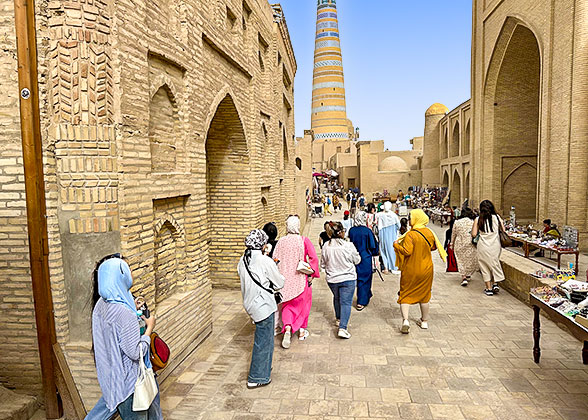
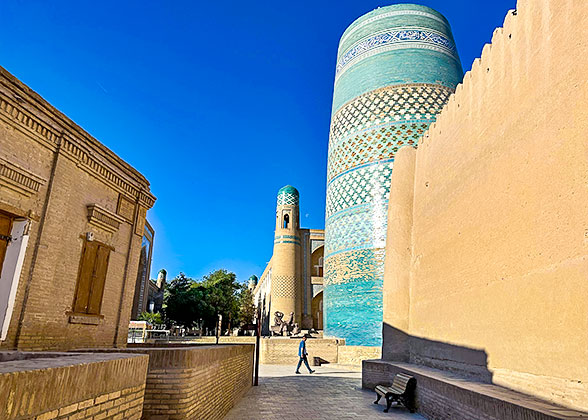
We’ll start at two ancient Islamic schools, the Muhammad Aminkhan Madrasah and Muhammad Rahim Khan Madrasah, where the city’s iconic Kalta Minor Minaret stands at the doorway. Unlike other minarets that taper to the top, Kalta Minor is a stout, cylindrical tower adorned with glazed, intricate Islamic geometric patterns and Arabic calligraphy. Then, a 2-minute walk will lead you to the Juma Mosque. Passing through the wooden door, let’s enter its main hall, supported by 218 wooden columns; some of them date back to the 10th century. All the pillars were said to be donated by past residents, and the delicately carved ones were from the rich, while those that remain rough-hewn timbers were from the less affluent.
Continue to the Tosh-Hovli Palace, the Khan’s residence, renowned for its alluring decorations. Here, not only will stone pillars with hollow carvings catch your eye, but also the walls bedecked with complicated motifs are dazzling. Dropping by the Pakhlavan Makhmud Mausoleum, we’ll reach the soaring Islam Khodja Minaret, the tallest minaret in Khiva, piercing the sky at 57 meters (187 feet). Finally, conclude today’s guided tour by ascending the ramparts of Kunya-Ark, where you can take a shot of the panoramic views across the ancient city. Afterwards, the remainder of the day is for your independent discovery.
Stroll leisurely through the lanes, browsing stalls brimming with traditional crafts, like vibrant carpets and hand-painted ceramics. Stop by the miniature store, where you may see the working process of artisans. Keep an eye out for the puppet theater performances near the city wall of Ichan Kala. If you are energetic, wait for the sunset to admire the symphony of orange sunlight and the shadow of the rampart.
Meals: Breakfast
Accommodation: Hotel Asia Khiva (3 stars) or similar

Ichan Kala of Khiva

Kalta Minor, Khiva
Day 6 Drive to Bukhara through Kyzylkum Desert
After breakfast, our driver will pick you up from the hotel and escort you across the vast Kyzylkum Desert to Bukhara, taking 7-8 hours on the way. Departing Khiva, we will drive along the mighty Amu Darya River. As we get closer to the desert, rust-red dunes dotted with sedge and white saxaul trees will gradually fill your view, and sometimes you may encounter wild camels. When we travel deeper into the desert, vegetation becomes thin, revealing an endless gilded arid expanse. Approaching Bukhara, you’ll find that the terrain transforms into a grey-brown steppe with patches of green. When the boundless cotton fields replace the sparse saxaul shrubs, it heralds the arrival in Bukhara. You’ll be accompanied to check into the hotel and then have a good rest.
With more than two millennia of history, Bukhara seamlessly integrates its ancient monuments with bustling bazaars and residential courtyards, offering an immersive experience of authentic daily life, and you can admire its centuries-old buildings. As one of the oldest cities in Central Asia, Bukhara was built in the 2nd century BC and reached its zenith during the 9th-10th centuries as the capital of the Samanid Empire. Though devastated by Genghis Khan in the 13th century, the city was rebuilt a century later under the governance of Amir Timur. Successive rulers have bequeathed over 140 historical buildings, ranking the city as a UNESCO World Heritage site.
 Free Time Suggestion: (at your own expense)
Free Time Suggestion: (at your own expense)
Heading to the Silk Road Spices Teahouse to experience Uzbek tea culture is a good option. This antique tea house, established in 2004, has become a popular destination among locals and visitors. Stepping in, your nose will be immediately filled with a whiff of herbs and spices. Beyond conventional green and black teas, consider trying cardamom saffron tea. This unique blend greets your palate with an initial bitterness and finishes with a sweet aftertaste, offering you a wholly distinctive tea experience. Besides, Turkish coffee is also served to coffee lovers.
Average Cost of Each Tea Set: UZS 50,000 (4 USD). Unlimited refills of hot water.
Address: Khakikat Str., Buxoro Viloyati, Uzbekistan
Meals: Breakfast
Accommodation: Volida Hotel Bukhara (3 stars) or similar
With more than two millennia of history, Bukhara seamlessly integrates its ancient monuments with bustling bazaars and residential courtyards, offering an immersive experience of authentic daily life, and you can admire its centuries-old buildings. As one of the oldest cities in Central Asia, Bukhara was built in the 2nd century BC and reached its zenith during the 9th-10th centuries as the capital of the Samanid Empire. Though devastated by Genghis Khan in the 13th century, the city was rebuilt a century later under the governance of Amir Timur. Successive rulers have bequeathed over 140 historical buildings, ranking the city as a UNESCO World Heritage site.
Heading to the Silk Road Spices Teahouse to experience Uzbek tea culture is a good option. This antique tea house, established in 2004, has become a popular destination among locals and visitors. Stepping in, your nose will be immediately filled with a whiff of herbs and spices. Beyond conventional green and black teas, consider trying cardamom saffron tea. This unique blend greets your palate with an initial bitterness and finishes with a sweet aftertaste, offering you a wholly distinctive tea experience. Besides, Turkish coffee is also served to coffee lovers.
Average Cost of Each Tea Set: UZS 50,000 (4 USD). Unlimited refills of hot water.
Address: Khakikat Str., Buxoro Viloyati, Uzbekistan
Meals: Breakfast
Accommodation: Volida Hotel Bukhara (3 stars) or similar
Day 7 Bukhara: Chor-Minor Madrasah, Trade Dome Market, Kalyan Minaret, Ark Fortress
Meet with your Bukhara guide at the hotel lobby, and get to today’s first destination, Lyabi Hauz Ensemble, at the heart of the city. Wander through its surrounding Islamic schools, Sufi sanctuary, restaurants, and boutique stores to the west, and the exquisitely carved terracotta façade of the Magoki-Attori Mosque will unfold. This is Central Asia’s oldest mosque, now housing a small museum, where you can see the carpets depicting figures of ancestors and remnants of Zoroastrianism.
Venture east through alleys to the Chor-Minor Madrasah, famed for its four towers whose top is covered in turquoise tiles, on which you can see different symbols of religions: Buddhist prayer wheels, Christian crosses, Zoroastrian fire altars, and Islamic crescent moons. Constructed in 1807, it is regarded as one of the typical structures of Islamic architecture and once appeared on the cover of Lonely Planet Central Asia.
After, step into the bustling Trade Dome market, where stalls are overwhelmed with handwoven carpets and copperware. Stop at two ancient Islamic schools, Ulugh Beg Madrasah and Abdulaziz Khan Madrasah, and then head to the Poi Kalyan Complex to look up at the 47-meter Kalyan Minaret soaring above the skyline. Its majesty survived when Genghis Khan conquered the city and razed most of the buildings in 1220, as the cruel conqueror was also spellbound by it. Behind the minaret stands the reconstructed Kalyan Mosque, one of Central Asia’s largest mosques, which can accommodate 10,000 pilgrims. Standing at its doorway, you’ll be staggered by the complicated Persian glazed tilework and Turkic geometric patterns on its portal. Adjacent lies the Miri-Arab Madrasah, built in the 16th century, and it is still operated as an Islamic academy today.
Moving westward, let’s enter the formidable Ark Fortress to explore the once royal living quarters, stables, and ancient mosques. At the prison, which once locked up two British envoys in 1842, you can see shackles binding mannequins, and people usually throw coins into the ward to console the souls. Ascend the rampart at sunset to capture the view of honey-hued battlements and Bukhara’s skylines scattered with cerulean domes. Today’s walking tour will conclude after admiring the reflections of the 20 columns of the Bolo Hauz Mosque, exploring the brickwork at the Samanid Mausoleum, and visiting the Chashma Ayub Mausoleum, revered for its healing waters.
Meals: Breakfast
Accommodation: Volida Hotel Bukhara (3 stars) or similar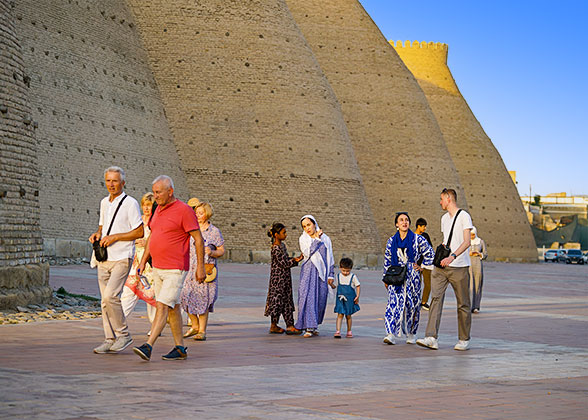
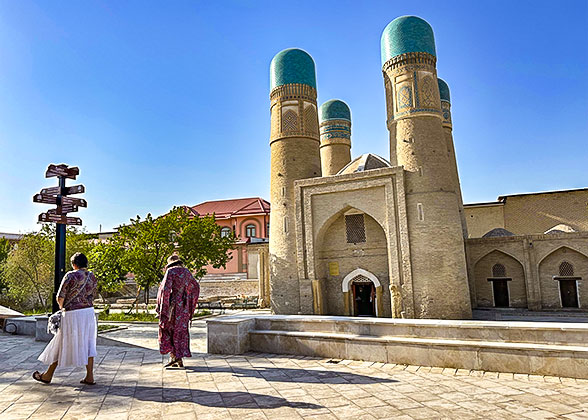
Venture east through alleys to the Chor-Minor Madrasah, famed for its four towers whose top is covered in turquoise tiles, on which you can see different symbols of religions: Buddhist prayer wheels, Christian crosses, Zoroastrian fire altars, and Islamic crescent moons. Constructed in 1807, it is regarded as one of the typical structures of Islamic architecture and once appeared on the cover of Lonely Planet Central Asia.
After, step into the bustling Trade Dome market, where stalls are overwhelmed with handwoven carpets and copperware. Stop at two ancient Islamic schools, Ulugh Beg Madrasah and Abdulaziz Khan Madrasah, and then head to the Poi Kalyan Complex to look up at the 47-meter Kalyan Minaret soaring above the skyline. Its majesty survived when Genghis Khan conquered the city and razed most of the buildings in 1220, as the cruel conqueror was also spellbound by it. Behind the minaret stands the reconstructed Kalyan Mosque, one of Central Asia’s largest mosques, which can accommodate 10,000 pilgrims. Standing at its doorway, you’ll be staggered by the complicated Persian glazed tilework and Turkic geometric patterns on its portal. Adjacent lies the Miri-Arab Madrasah, built in the 16th century, and it is still operated as an Islamic academy today.
Moving westward, let’s enter the formidable Ark Fortress to explore the once royal living quarters, stables, and ancient mosques. At the prison, which once locked up two British envoys in 1842, you can see shackles binding mannequins, and people usually throw coins into the ward to console the souls. Ascend the rampart at sunset to capture the view of honey-hued battlements and Bukhara’s skylines scattered with cerulean domes. Today’s walking tour will conclude after admiring the reflections of the 20 columns of the Bolo Hauz Mosque, exploring the brickwork at the Samanid Mausoleum, and visiting the Chashma Ayub Mausoleum, revered for its healing waters.
Meals: Breakfast
Accommodation: Volida Hotel Bukhara (3 stars) or similar

Ark Fortress, Bukhara

Chor-Minor Madrasah
Day 8 Bukhara: Summer Palace, Chor-Bakr Necropolis; High-Speed Train to Samarkand
Embark on a Bukhara side trip this morning with our guide and the driver. First, head to the Summer Palace (Sitorai Mohi-Hosa), a royal residence built in the 19th century, blending Central Asian and European architectural styles. It was said that at least three artisans were executed for delays in progress, and their bones were mixed into the mortar. The White Hall dazzles as the palace’s centerpiece, whose walls shimmer with Venetian and Japanese glass panels, and ceilings hang with a huge Polish chandelier. Further eastward, we will pilgrimage to the Memorial Complex of Bahouddin Naqshband, one of the world’s major Sufi sanctuaries, housing the tomb of the 14th-century saint, Bahouddin. Apart from the graves, a weathered oak tree stands in its courtyard, which is believed to bring fortune to those who touch its rough bark. Finally, pay your respects to the four saints of the Bakr family at their resting place, Chor-Bakr Necropolis. The complex comprises 30 annexes, including a pond, a garden, a mosque, tombs of royal families from the 16th century, minarets, and so on.
In the afternoon, the driver will escort you to the railway station for your high-speed train to Samarkand. After about 2 hours, our Samarkand driver will pick you up at the train station and transfer you to the hotel for check-in.
 Recommended Restaurant in Samarkand (at your own expense)
Recommended Restaurant in Samarkand (at your own expense)
After settling down, you can savor authentic Uzbek flavors at Alibek Somsa, a beloved local restaurant that specializes in somsa. At its open kitchen, you can witness how bakers turn the dough into parcels filled with mutton or beef and stick them on the scorching interior surface of the tandir clay oven. Have one bite, and the flavor of juicy meat filling wrapped in the crunchy pastry blooms on your palate.
Price per Somsa: UZS 10,000 (USD 0.7)
Address: Samarkand, Usmon Yusupov 5-tor ko'chasi, 1
Meals: Breakfast
Accommodation: Grand Samarkand Superior (4 stars) or similar
In the afternoon, the driver will escort you to the railway station for your high-speed train to Samarkand. After about 2 hours, our Samarkand driver will pick you up at the train station and transfer you to the hotel for check-in.
After settling down, you can savor authentic Uzbek flavors at Alibek Somsa, a beloved local restaurant that specializes in somsa. At its open kitchen, you can witness how bakers turn the dough into parcels filled with mutton or beef and stick them on the scorching interior surface of the tandir clay oven. Have one bite, and the flavor of juicy meat filling wrapped in the crunchy pastry blooms on your palate.
Price per Somsa: UZS 10,000 (USD 0.7)
Address: Samarkand, Usmon Yusupov 5-tor ko'chasi, 1
Meals: Breakfast
Accommodation: Grand Samarkand Superior (4 stars) or similar
Day 9 Samarkand: Registan Square, Bibi Khanym Mosque, Ulugbek Observatory, Shah-i-Zinda Necropolis
Today, our guide will pick you up at the hotel and lead you to the highlights of Samarkand. Together with Khiva and Bukhara, Samarkand completes Uzbekistan’s “Silk Road Troika”. Though razed by Genghis Khan in 1220, it was reborn as a 'blue jewel' in Central Asia under the governance of Amir Timur, who made Samarkand his capital after conquering the Transoxiana region, covering present-day Uzbekistan and the southwestern part of Kazakhstan.
We will first head to the Registan Square, which condenses the architectural style during the Timur era with colossal arched portals, cerulean domes, soaring minarets, and opulent interiors. Then, navigate to the boisterous Siyob Bazaar, where you can not only find fresh fruits, vegetables, vivid wooden carvings, and vibrant embroideries, but also various street foods, such as Obi non, the Uzbek bread.
Jostling out of the bazaar, let’s continue to the Bibi Khanym Mosque, once the biggest Islamic mosque in Central Asia, to gaze up at its ribbed celestial dome and towering portal embellished with star-like miniature paintings. Then, a short drive will transfer you to the Ulugbek Observatory in the suburbs. At this scientific marvel constructed in 1428, Timur’s grandson Ulugbek installed a groundbreaking 40-meter meridian sextant, and only a quarter of the original structure is preserved underground. It is unbelievable that Ulugbek compiled the star catalog only through naked-eye observation, and achieved unprecedented astronomical accuracy that remained unmatched for 150 years in Central Asia.
On the way back to the city center, we will drop by the Shah-i-Zinda Necropolis, the tombs of royal females from the Timur era, to glimpse the Persian calligraphy and floral arabesque-decorated walls. Finally, stand beneath the galaxy-like domes adorned with gold miniatures of the Gur-Emir Mausoleum to pay homage to the founder of Samarkand. At the end of the itinerary, the driver will send you back to the hotel.
 Where to Kill Time in Samarkand
Where to Kill Time in Samarkand
If you want to explore Samarkand deeply on your own, the Eternal City is recommended. It is a newly built commercial quarter recreating Timurid-era architecture. Stroll among its turquoise-domed buildings, mosaic-walled palaces, and sky-piercing towers, evoking a feeling of being in the story of the One Thousand and One Nights. Browsing stalls on the sides of the alleys, you’ll be dazzled by Uzbekistan's traditional hats and embroidered handbags. When night comes, the pedestrian will be illuminated by golden lights, and street performers will emerge onto the street, dancing to Uzbek folk melodies or singing traditional songs.
► Car-hailing Tip: It is convenient and safe to hail a car on Yandex Go, which allows you to bind a Visa. The app will provide an estimated fare, but remember to negotiate the price with the driver before departure to avoid being overcharged.
Meals: Breakfast
Accommodation: Grand Samarkand Superior (4 stars) or similar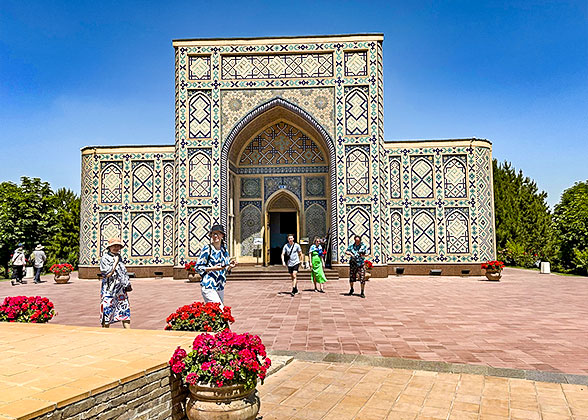
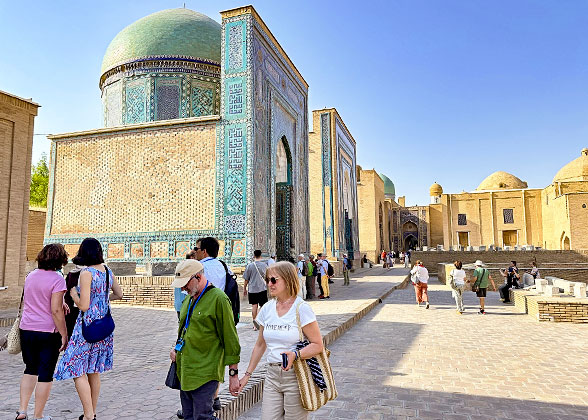
We will first head to the Registan Square, which condenses the architectural style during the Timur era with colossal arched portals, cerulean domes, soaring minarets, and opulent interiors. Then, navigate to the boisterous Siyob Bazaar, where you can not only find fresh fruits, vegetables, vivid wooden carvings, and vibrant embroideries, but also various street foods, such as Obi non, the Uzbek bread.
Jostling out of the bazaar, let’s continue to the Bibi Khanym Mosque, once the biggest Islamic mosque in Central Asia, to gaze up at its ribbed celestial dome and towering portal embellished with star-like miniature paintings. Then, a short drive will transfer you to the Ulugbek Observatory in the suburbs. At this scientific marvel constructed in 1428, Timur’s grandson Ulugbek installed a groundbreaking 40-meter meridian sextant, and only a quarter of the original structure is preserved underground. It is unbelievable that Ulugbek compiled the star catalog only through naked-eye observation, and achieved unprecedented astronomical accuracy that remained unmatched for 150 years in Central Asia.
On the way back to the city center, we will drop by the Shah-i-Zinda Necropolis, the tombs of royal females from the Timur era, to glimpse the Persian calligraphy and floral arabesque-decorated walls. Finally, stand beneath the galaxy-like domes adorned with gold miniatures of the Gur-Emir Mausoleum to pay homage to the founder of Samarkand. At the end of the itinerary, the driver will send you back to the hotel.
If you want to explore Samarkand deeply on your own, the Eternal City is recommended. It is a newly built commercial quarter recreating Timurid-era architecture. Stroll among its turquoise-domed buildings, mosaic-walled palaces, and sky-piercing towers, evoking a feeling of being in the story of the One Thousand and One Nights. Browsing stalls on the sides of the alleys, you’ll be dazzled by Uzbekistan's traditional hats and embroidered handbags. When night comes, the pedestrian will be illuminated by golden lights, and street performers will emerge onto the street, dancing to Uzbek folk melodies or singing traditional songs.
► Car-hailing Tip: It is convenient and safe to hail a car on Yandex Go, which allows you to bind a Visa. The app will provide an estimated fare, but remember to negotiate the price with the driver before departure to avoid being overcharged.
Meals: Breakfast
Accommodation: Grand Samarkand Superior (4 stars) or similar

Ulugbek Observatory

Shah-i-Zinda Necropoli
Day 10 Cross Border to Tajikistan; Panjakent - Istaravshan - Khujand
Leaving Samarkand, the driver will transfer you to the Uzbekistan-Tajikistan border, where the Tajik guide and the driver will pick you up and dash into Panjakent - the cradle of Sogdian civilization, established in the 5th century. Guardian of the trade routes from Samarkand to the Pamirs by the throat, it rose as a key node on the Silk Road, and the Sogdians accrued substantial profits by brokering goods among different empires. But the golden age ended when Arab forces sacked the city in 722, transforming Panjakent into the "Pompeii of Central Asia."
Stepping into the Republican Museum of History and Local Lore of Rudaki, you can trace back Sogdian stories by viewing their relics, including wooden carvings of a Sogdian dancing girl, 5,500-year-old pottery, gold funerary masks of Sogdian nobles, and traditional Tajik costumes. After passing through the local market teeming with local agricultural products and traditional handicrafts, let’s stop at the Rudaki Mausoleum, honoring the 10th-century "Father of Persian Poetry."
Then, a 4-hour drive will take you to Istaravshan, one of Central Asia’s oldest cities. The guide will first lead you to the Fortress Mug Teppe, in the northeast of the city, which has been overlooking the city since the 1st millennium BC. Although it was destroyed largely by Alexander the Great in 329 BC, it remains impressive after the 2005 reconstruction. If you climb up the citadel, you can capture a sweeping view of the surroundings. From afar, you’ll be intrigued by the blue dome of Kok Gumbaz Mosque, a rare Timurid-era architectural relic in Tajikistan. To gain an immersive experience of local life, you can wander around the local bazaar, which houses many blacksmith workshops offering a glimpse of calcining cutters. At the end of the day, we will drive to Khujand. Have a good rest after check-in at the hotel.
 Tajikistan Insider Information:
Tajikistan Insider Information:
1. Currency: Since credit cards are not widely used in Tajikistan, please exchange some Tajikistani Somoni (TJS) or small denominations of USD cash in advance. It is easy to find ATMs on the streets of Panjakent, and most of them only accept Visa cards.
2. Internet Connection & SIM Card: The internet signal in Tajikistan is weak in most regions and may only suit basic apps like Google Maps and Google Translate. The Tcell SIM card has the largest coverage, which allows slight use in remote areas. You can purchase one at border shops or Panjakent outlets, costing USD 3.19 for 1.5 GB of data.
Meals: Breakfast
Accommodation: Parliament Hotel Khujand (4 stars) or similar
Stepping into the Republican Museum of History and Local Lore of Rudaki, you can trace back Sogdian stories by viewing their relics, including wooden carvings of a Sogdian dancing girl, 5,500-year-old pottery, gold funerary masks of Sogdian nobles, and traditional Tajik costumes. After passing through the local market teeming with local agricultural products and traditional handicrafts, let’s stop at the Rudaki Mausoleum, honoring the 10th-century "Father of Persian Poetry."
Then, a 4-hour drive will take you to Istaravshan, one of Central Asia’s oldest cities. The guide will first lead you to the Fortress Mug Teppe, in the northeast of the city, which has been overlooking the city since the 1st millennium BC. Although it was destroyed largely by Alexander the Great in 329 BC, it remains impressive after the 2005 reconstruction. If you climb up the citadel, you can capture a sweeping view of the surroundings. From afar, you’ll be intrigued by the blue dome of Kok Gumbaz Mosque, a rare Timurid-era architectural relic in Tajikistan. To gain an immersive experience of local life, you can wander around the local bazaar, which houses many blacksmith workshops offering a glimpse of calcining cutters. At the end of the day, we will drive to Khujand. Have a good rest after check-in at the hotel.
1. Currency: Since credit cards are not widely used in Tajikistan, please exchange some Tajikistani Somoni (TJS) or small denominations of USD cash in advance. It is easy to find ATMs on the streets of Panjakent, and most of them only accept Visa cards.
2. Internet Connection & SIM Card: The internet signal in Tajikistan is weak in most regions and may only suit basic apps like Google Maps and Google Translate. The Tcell SIM card has the largest coverage, which allows slight use in remote areas. You can purchase one at border shops or Panjakent outlets, costing USD 3.19 for 1.5 GB of data.
Meals: Breakfast
Accommodation: Parliament Hotel Khujand (4 stars) or similar
Day 11 Khujand: Historical Local Lore Museum, Panjshanbe Bazaar, Arbob Cultural Palace
Today, the guide will accompany you to have a brief exploration of Khujand, the second-largest city in Tajikistan. Positioned at the gateway of the Fergana Valley, it not only thrived as a vital Silk Road nexus but also sparked conflict as a contested military stronghold during the Macedonian Empire (808-168 BC). Each ruler imprinted their legacy upon the city, forging Khujand’s unique cultural tapestry through a fusion of diverse architectural styles, religions, and customs.
Start sightseeing at the Historical Local Lore Museum of Archeology and Fortification, which was built atop the citadel ruin of the 8th-10th century, and its façade evokes a medieval fortress. Among its 1,200 artifacts, you can find statues of Central Asian mythological figures, ceramics, ironwork, and coins from the 5th to 12th centuries, and a grand mosaic mural depicting the life story of Alexander the Great. Then, stroll past the Mausoleum of Sheik Muslekheddin, the resting place of Tajik’s 12th-century poet and ruler, to admire its lime ceilings supported by marble columns. Nearby is the busy Panjshanbe Bazaar, one of the largest indoor markets in Central Asia, whose pink exterior walls are very outstanding. In the market, the aroma of freshly baked naan bread and spices pervades the air, and the dazzling hand-embroidered textiles will feast your eyes.
Proceed to the Arbob Cultural Palace, a museum renovated from an office building of a farm, which was said to be inspired by the Winter Palace in St. Petersburg and the Moscow Kremlin. Stepping up to the doorway of the palace, you can see the panoramic view of its central fountain plaza. Walking through the lobby dominated by the Greek-style columns and ascending upstairs, let’s have a brief overview of the history of the palace. Finally, conclude today’s sightseeing at the Kayrakkum water reservoir, a 160 sq km artificial lake locally dubbed the "Tajik Sea" for its boundless expanse. Wander along the shore and witness how the water’s surface transforms into a canvas reflecting the color of the sky. At the end, the driver will transfer you back to the hotel.
Meals: Breakfast
Accommodation: Parliament Hotel Khujand (4 stars) or similar
Start sightseeing at the Historical Local Lore Museum of Archeology and Fortification, which was built atop the citadel ruin of the 8th-10th century, and its façade evokes a medieval fortress. Among its 1,200 artifacts, you can find statues of Central Asian mythological figures, ceramics, ironwork, and coins from the 5th to 12th centuries, and a grand mosaic mural depicting the life story of Alexander the Great. Then, stroll past the Mausoleum of Sheik Muslekheddin, the resting place of Tajik’s 12th-century poet and ruler, to admire its lime ceilings supported by marble columns. Nearby is the busy Panjshanbe Bazaar, one of the largest indoor markets in Central Asia, whose pink exterior walls are very outstanding. In the market, the aroma of freshly baked naan bread and spices pervades the air, and the dazzling hand-embroidered textiles will feast your eyes.
Proceed to the Arbob Cultural Palace, a museum renovated from an office building of a farm, which was said to be inspired by the Winter Palace in St. Petersburg and the Moscow Kremlin. Stepping up to the doorway of the palace, you can see the panoramic view of its central fountain plaza. Walking through the lobby dominated by the Greek-style columns and ascending upstairs, let’s have a brief overview of the history of the palace. Finally, conclude today’s sightseeing at the Kayrakkum water reservoir, a 160 sq km artificial lake locally dubbed the "Tajik Sea" for its boundless expanse. Wander along the shore and witness how the water’s surface transforms into a canvas reflecting the color of the sky. At the end, the driver will transfer you back to the hotel.
Meals: Breakfast
Accommodation: Parliament Hotel Khujand (4 stars) or similar
Day 12 Khudjand to Kokand, Uzbekistan; Drive to Fergana & Stop by Rishton
The Tajik driver will escort you to the border of Uzbekistan, where the Uzbek driver will pick you up and lead you to Kokand, the core of the Fergana Valley. The local guide will accompany you to the Khudoyar-Khan Palace at the center of the city. Constructed in the 1870s, the palace originally boasted seven courtyards housing more than 100 chambers, most of which were destroyed by Russians in the early 20th century, leaving only two courtyards and 19 rooms. Thanks to the small museum in the palace, we can peek into the history of the building and its era. There is a reproduction of the Khan’s throne, and if interested, you can take a picture sitting on it. Leaving the palace, we will have a stopover at the Norbut-Biy Madrassah, the spiritual center of Kokand, and then continue to the Modari Khan Mausoleum. This azure-domed sanctuary will mesmerize you with its wooden carved porches and intertwined mosaic decorations. In the graveyard, you may encounter pregnant women draping white cloths and praying to the tomb for blessings.
Then, the driver will whisk you to Fergana’s hotel to stay overnight.
Meals: Breakfast
Accommodation: Hotel Asia, Fergana (4 stars) or similar
★ Watch the Making Process of Ceramics
Another 2-hour drive will lead you to Rishton, the 800-year-old pottery capital of Uzbekistan, which is said to have produced tiles for royal buildings during the Kokand Khanate (1709-1876). At the pottery workshop, you can witness how the artisans transform clay lumps into symmetrical vessels on the swirling kickwheels. The hand-drawn pieces will be glazed and put into the kiln for firing. The finished ones are glittering with cobalt blue or emerald.Then, the driver will whisk you to Fergana’s hotel to stay overnight.
Meals: Breakfast
Accommodation: Hotel Asia, Fergana (4 stars) or similar
Day 13 Fergana - Yodgorlik Silk Factory in Margilan - Andijan
Accompanied by our guide and the driver, today’s Fergana sightseeing will begin at the Ahmad Al-Fergani Monumental Complex to pay homage to the statue of the 9th-century astronomer, Fergani. A 30-minute drive will transfer you to Margilan, an ancient city known for its silk and handicrafts. At the 19th-century Said Ahmad-khoja Madrasah, see the combination of an Oriental courtyard framed by willow-leaf-like arches with a European-inspired prayer hall where marble columns support caisson ceilings and stained-glass windows cast kaleidoscopic light.
Then, pop in the Yodgorlik Silk Factory to explore the ancient silk-producing process. Masters will extract threads from boiled silkworm cocoons and then submerge the yarns in pigments. Following the clacking of the wooden looms, you’ll find how the strand turned into floral and geometric patterns in the weavers’ hands.
Leaving behind Margilan, the driver will escort you to Andijan, the birthplace of Zahiriddin Muhammad Babur, the descendant of Timur who established India’s Mughal Empire (1526-1858). The local guide will guide you to the leafy Babur Park located on the hill to see the statue of Babur. Behind it is the Babur Literary Museum, where you can learn about the ruler’s life story and literary attainment by viewing the ceremonial sword and manuscripts of his poets. Higher, you’ll encounter Babur’s empty tomb, whose real remains are buried in Afghanistan. For energetic ones, you can climb to the hilltop for a 360-degree view of the park and the city.
Today’s itinerary will conclude at the Art and Literature Museum, which showcases folk arts of the Fergana Valley, including vibrant suzani embroideries, miniature paintings depicting pastoral life, and traditional copperware. At last, settle down at the local hotel and have a good rest.
Meals: Breakfast
Accommodation: Toshkent Hotel, Andijan (3 stars) or similar
Then, pop in the Yodgorlik Silk Factory to explore the ancient silk-producing process. Masters will extract threads from boiled silkworm cocoons and then submerge the yarns in pigments. Following the clacking of the wooden looms, you’ll find how the strand turned into floral and geometric patterns in the weavers’ hands.
Leaving behind Margilan, the driver will escort you to Andijan, the birthplace of Zahiriddin Muhammad Babur, the descendant of Timur who established India’s Mughal Empire (1526-1858). The local guide will guide you to the leafy Babur Park located on the hill to see the statue of Babur. Behind it is the Babur Literary Museum, where you can learn about the ruler’s life story and literary attainment by viewing the ceremonial sword and manuscripts of his poets. Higher, you’ll encounter Babur’s empty tomb, whose real remains are buried in Afghanistan. For energetic ones, you can climb to the hilltop for a 360-degree view of the park and the city.
Today’s itinerary will conclude at the Art and Literature Museum, which showcases folk arts of the Fergana Valley, including vibrant suzani embroideries, miniature paintings depicting pastoral life, and traditional copperware. At last, settle down at the local hotel and have a good rest.
Meals: Breakfast
Accommodation: Toshkent Hotel, Andijan (3 stars) or similar
Day 14 Cross the Border to Osh, Kyrgyzstan; Fly to Bishkek
After breakfast, the driver will transfer you to the Dostyk border, and you’ll embark on the Kyrgyzstan exploration with our guide and the driver. Osh, one of Central Asia’s oldest cities, is our first destination. On the way to the city center, we will stop at the foot of Sulaiman Mountain, a spiritual center dotted with pilgrimage sites. The Sulaiman Mountain Museum, with a radar-shaped entrance, is believed to be a meditation cave of a Sufi saint in the 15th century. In its exhibition hall, you can see the reconstructed Zoroastrian ritual scenes, merchant pottery of Sogdian caravans, silk textile fragments from the Chinese Tang Dynasty (618-907), and ancient rock petroglyphs. Beyond, its viewing platform offers a panoramic cityscape of Osh.
Navigate to the city center and lose yourself among the mountains of spice and the pyramids of seasonal bounty in the vibrant local bazaar. Later, we will send you to the Osh Airport to catch the flight to Bishkek. As soon as you land, our local driver will pick you up and drop you off at the hotel.
 Currency Exchange: Since e-pay is not widely used in Kyrgyzstan, locals rely heavily on cash transactions. So exchange some Kyrgyzstani Som (KGS) with Visa, Mastercard, or USD cash at ATMs on the streets in Osh or Bishkek. It is also advisable to carry some small-denomination KGS for market purchases.
Currency Exchange: Since e-pay is not widely used in Kyrgyzstan, locals rely heavily on cash transactions. So exchange some Kyrgyzstani Som (KGS) with Visa, Mastercard, or USD cash at ATMs on the streets in Osh or Bishkek. It is also advisable to carry some small-denomination KGS for market purchases.
Meals: Breakfast
Accommodation: Ramada by Wyndham Bishkek Centre (4 stars) or similar
Navigate to the city center and lose yourself among the mountains of spice and the pyramids of seasonal bounty in the vibrant local bazaar. Later, we will send you to the Osh Airport to catch the flight to Bishkek. As soon as you land, our local driver will pick you up and drop you off at the hotel.
Meals: Breakfast
Accommodation: Ramada by Wyndham Bishkek Centre (4 stars) or similar
Day 15 Hike for 3-4 Hours in Ala Archa National Park, Drive 3 Hours to Chon Kemin
Please have a big breakfast this morning, as our guide will accompany you to venture into Ala Archa National Park. Located about 40 km (24 mi) south of Bishkek, Ala Archa is part of the Heavenly Mountains of Kyrgyzstan, whose elevation ranges from 1,500m (4,900 ft) to 4,895m (16,000 ft), weaving together ice-capped summits, pine-cloaked gorges, and torrential meltwater rivers into an alpine tapestry. Following the rugged trails, let’s ascend through juniper forests, where the fragrance of resin pervades the mountain air, sunlight filtering through canopies dapples the path, and glacial streams cascade down cliffs. The route will culminate at the “Broken Heart”, a colossal granite formation split asunder, revealing a panoramic vista of the valley from its summit.
► Tip: It is advisable to wear suitable hiking shoes for the unpaved trails, and prepare long-sleeved clothes due to the lower temperatures in the mountains even in summer. Besides, please pack some bottled water and snacks, since there are no shops in the park.
Post-hike, a 3-hour transfer will deliver you to Chon Kemin Village, nestled within a valley. Steel and concrete forests give way to the undulating meadows, woodlands, and rivers. After settling down into the guesthouse, just follow our guide’s steps, wandering along the riverbank or deep into the forest to collect pinecones. For a more exciting experience, you can ride a horse at your own expense to the valley.
Meals: Breakfast
Accommodation: Kok Archa Guesthouse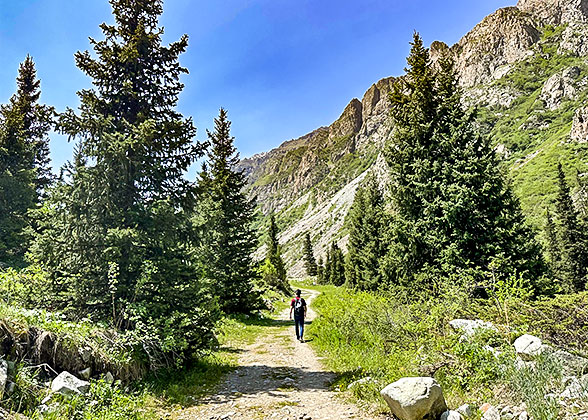
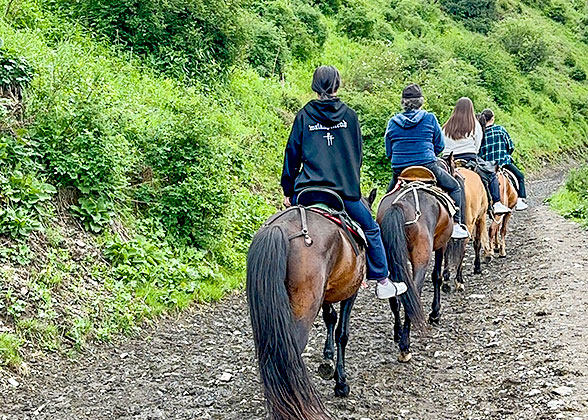
► Tip: It is advisable to wear suitable hiking shoes for the unpaved trails, and prepare long-sleeved clothes due to the lower temperatures in the mountains even in summer. Besides, please pack some bottled water and snacks, since there are no shops in the park.
Post-hike, a 3-hour transfer will deliver you to Chon Kemin Village, nestled within a valley. Steel and concrete forests give way to the undulating meadows, woodlands, and rivers. After settling down into the guesthouse, just follow our guide’s steps, wandering along the riverbank or deep into the forest to collect pinecones. For a more exciting experience, you can ride a horse at your own expense to the valley.
Meals: Breakfast
Accommodation: Kok Archa Guesthouse

Ala Archa National Park

Ride a Horse to Enjoy the Scenery
Day 16 Chon Kemin to Burana Tower, Bishkek Airport See-off
As dawn breaks, we will journey toward the Burana Tower, whose silhouette can be easily seen from afar, rising above the plain. This 11th-century minaret was part of the ancient Balasagun city, soaring over 40 meters (130 feet), but now stands at about 24 meters (80 feet). Legend has it that the upper tier was shattered by the wails of a king whose daughter was killed by a spitting spider on her 16th birthday. You can ascend the narrow staircases to its top to overlook the steppe stretching to the foot of the Heavenly Mountains. Near the tower, you can find a patch of fields scattered with Balbal Turkic grave markers featuring carved warrior faces. Afterward, the driver will transfer you to the Bishkek Airport for your departure flight. Safe travels home!
Should the ancient Islamic heritage, the natural beauty of the mountains and the grasslands, or the intriguing nomad culture call you, we are ready to tailor itineraries for you to explore Kyrgyzstan further or head to Tajikistan. Contact us at any time!
Meals: Breakfast
Should the ancient Islamic heritage, the natural beauty of the mountains and the grasslands, or the intriguing nomad culture call you, we are ready to tailor itineraries for you to explore Kyrgyzstan further or head to Tajikistan. Contact us at any time!
Meals: Breakfast
Expand All
Collapse All
This trip can be customized to meet your individual needs!
Itineraries you may also like:
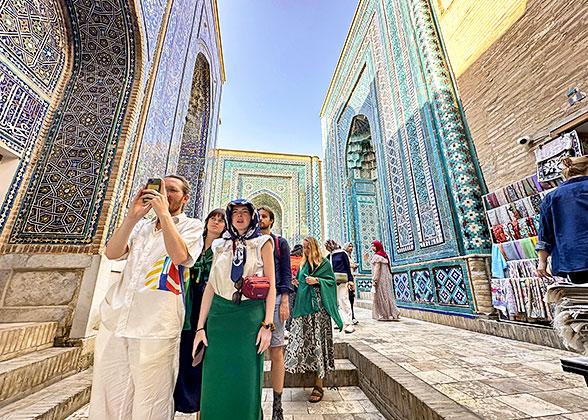 8 Days Tashkent - Samarkand - Bukhara - Kyzylkum Desert - Khiva - Urgench - Tashkent from USD1319
8 Days Tashkent - Samarkand - Bukhara - Kyzylkum Desert - Khiva - Urgench - Tashkent from USD1319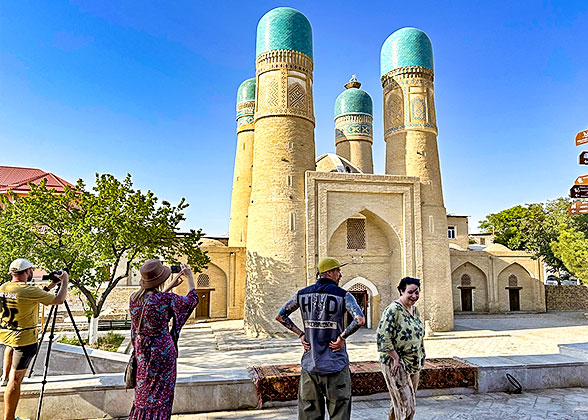 10 Days Tashkent - Urgench - Khiva - Kyzylkum Desert - Bukhara - Nurata - Safari Yurt Camp - Samarkand - Tashkent from USD1539
10 Days Tashkent - Urgench - Khiva - Kyzylkum Desert - Bukhara - Nurata - Safari Yurt Camp - Samarkand - Tashkent from USD1539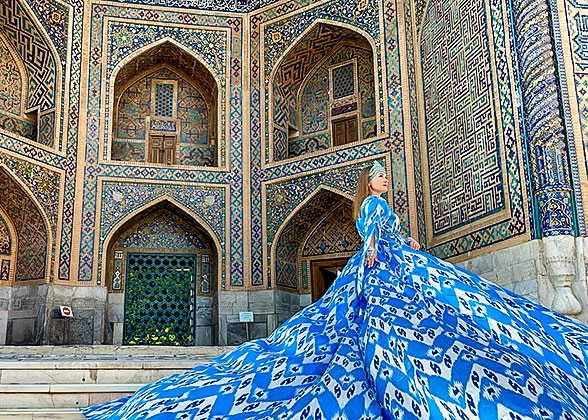 11 Days Tashkent - Nukus - Muynak - Nukus - Khiva - Kyzylkum Desert - Bukhara - Shakhrisabz - Samarkand - Tashkent from USD1803
11 Days Tashkent - Nukus - Muynak - Nukus - Khiva - Kyzylkum Desert - Bukhara - Shakhrisabz - Samarkand - Tashkent from USD1803
